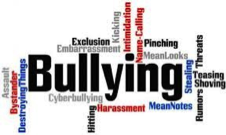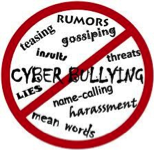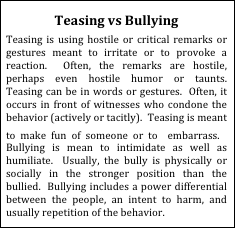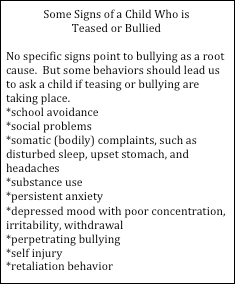I. Traumatic Impacts
 I asked Howard, a 60 year-old man with a history of depression, about the social shyness for which he sought my help. Then, he told me the story of how he had been teased and bullied years before.
I asked Howard, a 60 year-old man with a history of depression, about the social shyness for which he sought my help. Then, he told me the story of how he had been teased and bullied years before.
“When I was in the fifth grade, we moved from a neighborhood where I’d grown up the first 10 years f my life. I had friends and felt pretty good about myself. One of the fastest runners in the school, I could hit a baseball far for a 10 year-old. In retrospect, I guess I felt very equal to my friends. It was back at a time when kids had free run of the neighborhood from the library about half mile away to the big park across a busy street to a neighborhood shopping strip a few blocks away where there was a popular deli. My father used to take me there for breakfast before we would go for an outing on a Saturday. Or give me ten dollars and a list of things to buy from the bakery counter and bring home.
“Then we moved up to a more affluent area where the kids were way more sophisticated than where I had grown up. They dressed in the latest clothes, knew all the latest popular music, even knew how to dance. The athletic boys knew how to play basketball. There was no basket in the play ground at my old school, and I didn’t know anything about the game.
“So, I remember being teased by the popular kids for what we would now call being a nerd. How being clever turned into a bad thing puzzled me completely. My clothes didn’t fit in; I was ashamed of that. Someone teased me for my facial features, which were ordinary, I guess. I have to admit that a couple of years later I joined in picking on another kid for his looks. I guess we knew we were being cruel for no good reason. No, I didn’t have one particular villain. Just that there were several kids who had nothing to do with me except to say derogatory things. That hurt.
“But there was this one kid, Billy, a real troublemaker, who took everything one step farther. He was scary. He ended up in a reform school. That’s what they called it in those days, you know, for the dangerous kids. If one kid would only go so far as to say I was a bookworm – an old term for nerd, I guess – Billy went further, knocking the books out of my hand. Once, he knocked them into a puddle. If a kid might just say my nose was too big, that Billy put his palm over my face and pushed me. He always took it farther than anyone else. If some one said something about my clothes, he’d pull me by a shirt, ripping off a button, or yank the back of my collar until I fell. A real piece of work. We was a mediocre athlete, but he liked to show off that he had the best looking girlfriend or the biggest entourage. So, he would come by the school yard, but not right after school. Later. So, I got to play baseball or learn basketball. I knew to clear out by 4:30 or so, if I remember right, and keep out of his way.
“I tried so hard to excel at what seemed important there. Like learning to dance. Spending hours learning to dribble and shoot baskets and field baseballs. I got some cool clothes – one of the kids who befriended me showed me how to pick.
“But I became a follower, and did not have the same level of self-esteem as in the old neighborhood. I became self-conscious, I always worried about my impression on others. I still am. That was not part of my thinking before moving there. So, then I got to be shy in the sense of afraid to approach people. I thought they would feel I was a bother. I defined myself as unpopular. That’s what I was. My friends could criticize me and I’d take it; I’d think there actually was something wrong with me which I had to fix. As time went on, my distance from the popular kids became a universe; so I just thought of myself as part of the unpopular and different group.
“Even over four decades later, what stands out most immediately from those days is the memory of the ‘lowlights!’ I mean the various teasing comments. I can remember a lot of good things, but the unpleasant stuff is what comes up in my mind first.
“It was not just the kids. My three most immediate memories of high school are a teacher of Spanish mocking me on the first day. It seems the teacher from the previous year must have said to her that I was good in Spanish and I raised my hand a lot. So a source of self-worth by being smart got put down on the first day in her class when she said in a critical way which was, I am sure, meant to put me down, “Oh, Howard ______, I heard about you, yes, Howard _______, I heard about you.”
mocking me on the first day. It seems the teacher from the previous year must have said to her that I was good in Spanish and I raised my hand a lot. So a source of self-worth by being smart got put down on the first day in her class when she said in a critical way which was, I am sure, meant to put me down, “Oh, Howard ______, I heard about you, yes, Howard _______, I heard about you.”
“I remember feeling now there was almost nothing I could do to be accepted anymore. An English teacher made fun of me in class for a silly mistake on a test. I guess being a good student gets you blasted when you screw up. And a physics teacher did the same. I had winged it on a test – my fault for not studying more – and got a very poor grade. But the teacher didn’t have to announce it in class. I spent a week feeling two feet tall.
“After that, I felt equally bad when I aced a test and set a curve. Like no one would like me for that.”
“Fortunately, the skills I had shown when we moved to the neighborhood, which included spending hours practicing and a determination to master skills, helped me a lot. In my mind, getting near perfect grades in physics, a compulsion with me the rest of that year, showed up the teacher. Of course, that’s how the bullied think, that any future performance is in some kind relationship to the teasing. Proving you are better than they say. Or confirming you are as bad as they say. Now, it dawns on me the teacher probably felt reinforced by my improvement; she could get the impression that, if you mortify the kid, then he’ll do better!
Howard concluded, “I’ve been reasonably successful. But still I am afraid to approach people for fear of what they may say. Still I wonder if someone will sting me about my hair, of which there is obviously so much less, or my features or my clothes. So I pay too much attention to trying to impress people with my sports car, my bold colored clothes, art work, my upscale address, being in shape, playing great golf, trying to fit in. It’s a battle that can never be won. Each day that feels good and I think I am something special runs into the next when I am low and have to prove myself. So I’m depressed.”
Brittany told a different story. At 56, she told the story of events 40 years before. More emotional than Howard, she was too upset to get into all the details. “I was slow to mature. So already when I was 13 or 14, I was noticed for being different, the outsider. But then the acne came. All kids got it in those days. Is it my imagination or it way less prevalent today? Look,” she said, pointing to her face, “pock marks. Lots of them. That’s why I wear a lot of make up.”
“The boys would call me names I won’t repeat. The girls, well, some took pity, which made me feel worse somehow. A few understood. There just wasn’t much you could do for it. Antibiotics. Washes. Visits to the dermatologist. Didn’t help all that much.
“Then there were the girls – nowadays we would call them ‘Mean Girls.’ Wow. They were brutal. I also had big cystic pimples on my back and the girls could see that in the locker room. They said and did things to make me feel contaminated, like it would infest them. I still can’t stand being looked at too much.
In fact, Brittany did far more to compensate than her story suggested. She developed an obsession  with her appearance and a ritual compulsion to armor herself with medications, makeup, scarves, and a hairdo which would mask her scarring as much as possible. She had to get up an extra hour early in the morning in order to go through the ritual. Spontaneity was forbidden in her world.
with her appearance and a ritual compulsion to armor herself with medications, makeup, scarves, and a hairdo which would mask her scarring as much as possible. She had to get up an extra hour early in the morning in order to go through the ritual. Spontaneity was forbidden in her world.
These stories came to mind when I read a Chicago Tribune article, “The debilitating scars of bullying” by Candy Shulman (February 8, 2015)*. Her brave disclosures demonstrate the inner experience of someone being teased. She notes that some years later, the bullied continue to think about the mistreatment while the bully often remembers nothing of his or her behavior.
Shulman’s story mirrors the stories of Howard and Brittany*. Particularly noteworthy is how the object of teasing and bullying develops a mindset that she is being bullied and has to protect herself from it even when it is no longer happening. Shulman thinks of it as a victim mind set.
She also points out how bullying shapes social perception and expectations. For example, she mentioned the expectation of hurt and loss, behaviors engendered by her childhood bully, which generalize to new situations later in life and throughout adulthood.
Similarly, Howard and Brittany spent their adult lives continuing to stave off teasing and trying to achieve a feelings of acceptance, feelings of which they had felt deprived during adolescence. Each forecast a likelihood that new situations and new people would treat them in the same humiliating and hurtful ways as they had experienced in adolescence. They compensated in ways they imagined would fend off attacks. This is classic avoidance behavior – continue to react as if the assault is coming even after the threat no longer occurs. We carry the threat around mentally and act as unremitting victims.
One of the most extreme reactions to bullying is to identify with the perceived violence of it and then to perpetrate violence upon the self or upon others. That makes the news. Suicidal thinking and suicidal actions as a result of bullying are amongst the strongest of reactions to it. Completed suicides attributed to bullying are often reported by the media. Mass shootings by teens and young adults are often explained as associated with chronic bullying. They have led to a movement to shift the attitudes of educators from overlooking bullying or rationalizing it to the expectation they will prevent it or stop it.
But one in five children report being bullied. Sometimes, the damage may be significant enough to shape lives, as we see with Howard, Brittany, and Ms Shulman.
shape lives, as we see with Howard, Brittany, and Ms Shulman.
In these days, one can cyber-bully, namely, leave teasing or hurtful comments on the Internet or in a chat or email or on Facebook. The cruel words do not vanish, but remain visible. Rather than delivering teasing in person, the comments can be hurled from a safe distance. I wonder if that makes it easier to issue teasing. I wonder if the words are more impactful when on the Internet.
 Another example comes to mind. Jesse* was 16 when his mother brought him to see me. It was March. He went to school for sophomore year for about two weeks back in September. Since then he had not been back to school. This was before schools had to have programs for children who were unable to go to school due to illness or, in Jesse’s case, emotional problems.
Another example comes to mind. Jesse* was 16 when his mother brought him to see me. It was March. He went to school for sophomore year for about two weeks back in September. Since then he had not been back to school. This was before schools had to have programs for children who were unable to go to school due to illness or, in Jesse’s case, emotional problems.
I had previously treated a number of children with school phobia, a form of separation anxiety in which the child is afraid to be away from parents or home. Often the child fears some dire event may take place when he or she is away or the parent may leave the family.
With Jesse, we found no evidence for school phobia. He was depressed, sad, and soft-spoken. He showed little emotion overall. A behavioral analysis of his problem with school showed that he feared two situations. 1) If kids in the hallways were loud, the noise startled him. He expected a fight would break out. He assumed it would become violent, and he could be hurt in the melee. While he had seen fights, he had never actually been harmed. 2) If he walked into class and anyone was already in the room, he expected to be watched and judged. He thought the other kids would think he was strange. He would feel embarrassed. He then thought that he would be singled out to be victimized. The escape from social situations due to the fear of being judged by others is a symptom of a mental disorder known as Social Phobia.
That particular situation in class had actually never happened. However, he had often been teased by an older brother. So the memory of that teasing was being generalized to the school setting. Furthermore, Jesse believed his father sided with his brother. So Jesse generalized that school employees – teachers and administrators – would not protect him. He expected they would join in the negative behavior. So in his world, there was no protection except to avoid the situation and hide at home. In his belief system, he had defined himself as a vulnerable victim.
At home, he did not feel entirely safe. His imagined fears made him anxious even there. But he felt relief that as a result of his avoidance no new episodes of harm could occur.
In order to motivate him, Jesse’s father took a stance many parents might take. In hopes of motivating the young man, Father admonished him, told him that at this rate he would not amount to anything, and said high school should be a good time in life. To Jesse, however, these efforts confirmed his feeling of being misunderstood, unprotected, and not measuring up to other children. In contrast to Father, Jesse’s mother tried to comfort him. She pleaded with him to go to school. She felt helpless to motivate him. As a result, many days would pass when she said nothing about his avoidance. When she backed off, Jesse experienced what we call intermittent negative reinforcement, namely, the relief that he could stay home while the unpleasant interactions in the family would not occur that day. Such avoidance behavior is remarkably stable and long-lasting.
 Jesse’s mother had gone to school to complain to the Assistant Principal. However, the latter did not give her and Jesse a sense that the young man could be protected. Rather, the school threatened the family with repercussions for their son’s truancy.
Jesse’s mother had gone to school to complain to the Assistant Principal. However, the latter did not give her and Jesse a sense that the young man could be protected. Rather, the school threatened the family with repercussions for their son’s truancy.
In contrast to school phobia, Jesse presented with Social Phobia and school avoidance, failure to attend school due to a fear of the school setting or of other children. He had experienced some teasing, and he had witnessed bullying.
Can one be affected vicariously by witnessing bullying? Yes, indeed. Jesse projected himself into the shoes of kids he witnessed being bullied. He imagined what it would be like if that happened to him. He felt terrified by his thoughts. He imagined the helplessness that he felt standing by as a witness would be magnified if he were the actual victim. By remaining on the periphery of his school mates, he had few ties at school to motivate him to go just for positive social interactions with friends.
Whereas Howard’s and Brittany’s stories show the lasting effects of teasing and bullying, Jesse’s story shows the impact at the time it is happening. It even shows how witnessing others being bullied can affect bystanders. The story demonstrates how difficult it can be for parents to select an effective strategy to manage the situation.
The good news here is that Howard and Brittany had compensated effectively. So for them, the task in therapy was to help them desensitize the memories, change beliefs about themselves, and free themselves to experience contemporary life as it is, not as an echo of the past. In contrast, the therapeutic task for Jesse was more challenging. Namely, he did not have the successful life experiences Howard and Brittany could use in order to shift their thinking. He had limited emotional and family resources. Furthermore, the changes needed to help him were not going to be mainly internal changes as we saw with Howard and Brittany. Jesse actually had to overcome inertia, avoidance, and fear and start going to school. In school, he would need a more positive set of experiences so that he would experience positive reinforcement for going rather than negative reinforcement for staying home. Also, both of his parents would need to learn more effective strategies for managing the situation.
And they did. While Jesse participated in a program of reprocessing his fears, Mother was willing to participate in a graduated program in which Jesse dressed for school and she drove him to the school, then home, without going in. When his anxiety at that subsided, she could escort him to the door, then home. After a few days of that, she escorted him through the hallway to the office. Later, she stood by the office and watched him walk through the hall on his own, even when other kids were present. Meanwhile, we reprocessed the fear of walking into a classroom and rehearsed going into class. Eventually, Jesse managed to go and to sit through a class. He used some tools we had discussed and practiced, including some 3 X 5 cards on which we wrote statements to help him cope, such as, “I can sit quietly. After one minute, when I look around, I see no one is paying attention to me.” “My prime job is listening to the teacher.” The following September, Jesse was going to school full days. We had rehearsed strategies for having his parents interrupt any negative interactions with his brother, and family life became more pleasant for everyone in the home.
participate in a graduated program in which Jesse dressed for school and she drove him to the school, then home, without going in. When his anxiety at that subsided, she could escort him to the door, then home. After a few days of that, she escorted him through the hallway to the office. Later, she stood by the office and watched him walk through the hall on his own, even when other kids were present. Meanwhile, we reprocessed the fear of walking into a classroom and rehearsed going into class. Eventually, Jesse managed to go and to sit through a class. He used some tools we had discussed and practiced, including some 3 X 5 cards on which we wrote statements to help him cope, such as, “I can sit quietly. After one minute, when I look around, I see no one is paying attention to me.” “My prime job is listening to the teacher.” The following September, Jesse was going to school full days. We had rehearsed strategies for having his parents interrupt any negative interactions with his brother, and family life became more pleasant for everyone in the home.
As a psychotherapist, I come into the picture after the damage has been profound. The treatment approach is to desensitize memories and experiences of teasing and bullying, overcome avoidance, increase skills to manage the situation, shift thinking from victimhood and defectiveness to assertiveness and adequacy, re-design family interactions, and enlist supports from school personnel. In a follow-up essay, we will discuss some ways for parents to work with children to prevent or stop teasing and bullying before damage occurs, before psychotherapy may be required.
*Reference for the Schulman story:
*Note: The names and details of the stories of Howard, Brittany, and Jesse have been altered in order to substantially disguise the identities of real individuals.